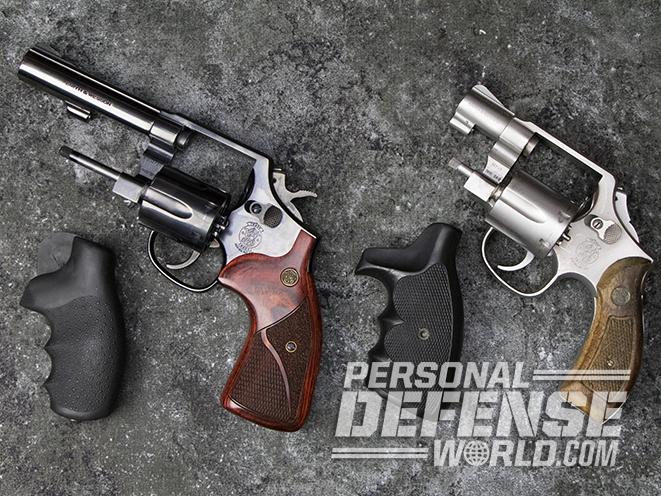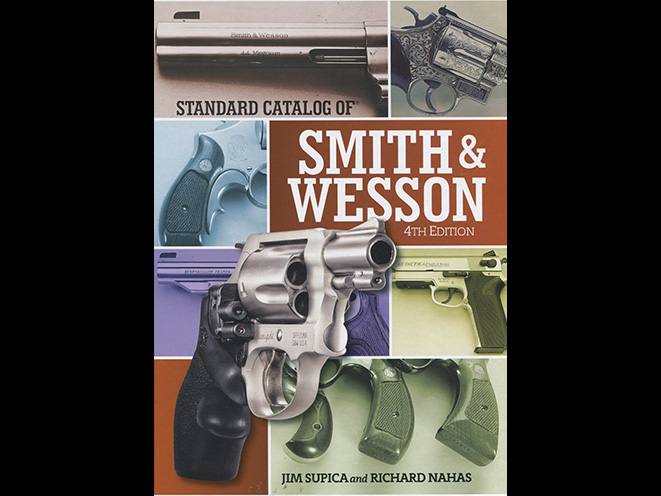Wheelguns may not receive the same consideration from buyers they once did, but that doesn’t mean they are ineffective tools for self-defense. Competition shooters like Jerry Miculek have shown that revolvers can be very fast. Decades of use in military and law enforcement settings have proven revolvers to be both effective and reliable. Like any tool, the revolver has its own special set of considerations that need to be taken into account if you wish to improve your efficiency with it. Most efficiency improvements require an investment of time in training and practice. Other improvements can be made through careful choices in upgrades. Let’s take a look at a few things that can help you rev up your wheelgun efficiency.
Dry Firing

If there is one aspect of shooting that can improve your accuracy and speed more than anything else, it is trigger control. In my experience, the short distance that the trigger moves has the biggest impact on where the bullet flies when it exits the barrel. Barring professional training, it has been my experience that one of the best ways to improve trigger control is through dry firing.
Dry firing costs no money and can be safely done at any time in your home. Consistent practice of good techniques can cause a measurable improvement in your ability to put rounds on target. Of course, not all practice is equal. Just pulling old Roscoe out and stroking the trigger without any specific training goal isn’t likely to help. Keep in mind that practice does not make perfect; rather, practice makes permanent. If you dry fire with bad techniques, you will simply ingrain the poor performance.
Advertisement — Continue Reading Below
- RELATED STORY: 8 Reasons Why Revolvers Are a Great Choice for New Shooters
There are a variety of dry-fire drills that you can do. One of the most basic uses a penny to improve your trigger control. Start by ensuring the gun is unloaded and there is no ammo in the room with you. Find a safe direction like an exterior wall, and then tape a target to that wall. Check again to make sure the gun is unloaded.
Take the gun in a firing grip and get into a comfortable stance. Aim at the target. Then place a penny on the end of the barrel. Your goal is to dry fire while aiming at the target without the penny falling from the end of the gun. Over time, you should be able to complete more and more pulls without the penny falling from the gun. This should be a good sign to you that you are exerting more and more control over the gun. Don’t overdo it; just spend five minutes a day working on this. After a month, I’m willing to bet that you’ll see an improvement in your shooting.
Of course, there is some debate about dry firing, and some instructors do not believe it adds much value to your ability to shoot accurately. I can only say that in my experience, it worked wonders for me when I was first learning to shoot a revolver. Additionally, I’ve seen it work very well for others.
Advertisement — Continue Reading Below
Faster Reloads

If there is one area where the revolver really lags behind the semi-automatic pistol, it is in reloading. Without a doubt, the semi-auto can be reloaded faster and easier than a revolver. That doesn’t mean you can’t quickly and efficiently reload your wheelgun, however. You can, but it requires practice and a little help from a reloading tool.
Probably one of the best revolver reloading tools I’ve found is the Safariland Comp II Speedloader. This small device securely holds a full cylinder’s worth of ammunition. When you dump the fired cases from your revolver, the Comp II Speedloader allows you to slap six more rounds right back into the gun. Comp I Speedloaders are a little more compact and come in sizes appropriate for five-shot revolvers.
The one drawback to the Comp I and II Speedloaders is that they tend to be a bit bulky for carrying in a pants pocket. Bianchi offers an alternative called Speed Strips. These flexible strips hold up to six rounds in a row by the cartridge rim. To use them, two cartridges are inserted into chambers and the strip is peeled off. While a little slower than a Speedloader, Speed Strips are faster than loading cartridges singly. Additionally, the Speed Strips keep the rounds together while carried concealed.
Advertisement — Continue Reading Below
Re-Grip And Rip

One change you can make to your revolver that can improve your handling is the grips. Grips are that all-important interface between your hand and the gun. A well-matched grip optimizes your finger placement on the trigger and enhances your ability to control the gun during recoil.
There are many hand sizes in the world, and no matter how nice the factory grips are, no one pair will fit everyone the same. The grips that come on a revolver will fit a certain number of people well. However, there is a good chance that people with small or large hands will not have an ideal fit. That’s where companies like Hogue, Pachmayr and VZ Grips come into play. These companies all offer a variety of grips made in different sizes with a range of styles and materials.
It is impossible for me to tell you which grips to buy for your revolver without knowing your size or preferences. It is tough enough to find the right grip for myself. I have a box of revolver grips I’ve bought over the years to prove it. I highly suggest going to your local gun shop and having them show you the options available for your revolver.
Advertisement — Continue Reading Below
Faster Sights

As with any other combat handgun, good sights can make a big difference in your accuracy. Starting my professional gun-carrying career with a S&W Model 10, I learned to shoot using a plain black ramp front sight aligned in a rear notch that was integral with the gun’s frame. It worked, but it wasn’t ideal.
The front ramp wasn’t replaceable without the use of an angle grinder, but I still found a workaround that helped improve how quickly I could find the sight: finger nail polish. Sure, I felt a little uncomfortable picking out the brightest colors of polish I could find in the cosmetics section of the local pharmacy. A little discomfort, however, proved to be worth it.
Advertisement — Continue Reading Below
I tried a number of colors and eventually settled on a bright white for the front sight. Three thick coats of the polish made the sight much more visible, and the polish was tough enough to stand up to daily carry use. Even Hoppe’s No. 9 didn’t seem to affect it. When I bought a matte-silver-finished S&W Model 642, I found that bright pink worked better than white as a contrast in the rear notch. Regardless of what bright color you choose, I recommend using a coat of white polish first. Adding the final color on top of the white layer seems to give it a brighter appearance.
If you don’t care to wander down the cosmetics aisle, no problem. Birchwood Casey makes a set of three paint markers for just this purpose. The kit includes white, neon green and fluorescent red. These paint markers have a felt tip that allows you to apply the paint fairly easily. Just take your time and you shouldn’t have any problems.
If you have a front sight that is replaceable, you have a great deal more flexibility. Companies like XS Sight Systems and HiViz Shooting Systems offer a variety of upgrades for revolver shooters. Like grips, replacement sights can be a largely subjective upgrade. For self-defense, I generally suggest something with a large front sight that is of a bright, contrasting color.
Advertisement — Continue Reading Below
Serious Revolver Training

As much as a few new pieces of gear can help improve your shooting, the fact is that nothing can replace training. When it comes to revolver training, there are few I would label expert instructors. One of them is Grant Cunningham. Without hesitation, he is the man I recommend to anyone needing wheelgun training.
- RELATED STORY: 23 New Revolvers Hitting the Marketplace in 2017
I’ve had the opportunity to observe Cunningham’s Threat-Centered Revolver class, and I was impressed with his knowledge, ability to communicate and the respect he shows his students. In addition to getting the best training on how to efficiently run a wheelgun, Cunningham introduces students to the realities of a self-defense encounter based on his experiences and the wealth of data he has collected and distilled. While he will push you to improve, his class is not filled with the comical puffed-chest machismo that many instructors exude. His rifle and pistol classes are also excellent, but he is unequaled in wheelgun training.
Additional Reading

Advertisement — Continue Reading Below
No matter how much I might encourage you to attend one of Cunningham’s revolver classes, I know that most people don’t have the time, money or desire to travel for a multi-day training session on the range. That doesn’t mean you can’t learn more about how to efficiently run your wheelgun from an expert like Cunningham.
When choosing a wheelgun for concealed carry, most people are likely to carry a snub-nose revolver. If this is you, I highly recommend checking out a book called “Protect Yourself with Your Snubnose Revolver.” This book was recently published by Cunningham on both the Kindle and iBooks platforms. Additionally, physical copies of the book can be purchased through Amazon.
In this book, Cunningham discusses many of the same concepts that he teaches in his classes. Concepts like efficiency in shooting and preparing for the most likely scenarios instead of every remote possibility. Additionally, he gives solid advice on ammunition selection, proper grip, unsighted fire and using the sights efficiently.
Advertisement — Continue Reading Below
While I am on the topic of revolver books, I would be remiss if I did not mention one more. As much as I like to shoot revolvers, I also enjoy collecting them. I suspect there are many of you who do the same. If you like classic Smith & Wesson wheelguns, there is no better resource than the “Standard Catalog of Smith & Wesson.”
This is a comprehensive look at all of the guns to come from the company from its inception through today. For me, however, the best part of the book is the extremely detailed information about the company’s revolvers. The book has original photos of the different models, information on special runs and details about rare variations. Without any doubt in my mind, it is the best resource on S&W revolvers available anywhere. The latest edition of this book was released in November of 2016, and it should be available at any book retailer.

































